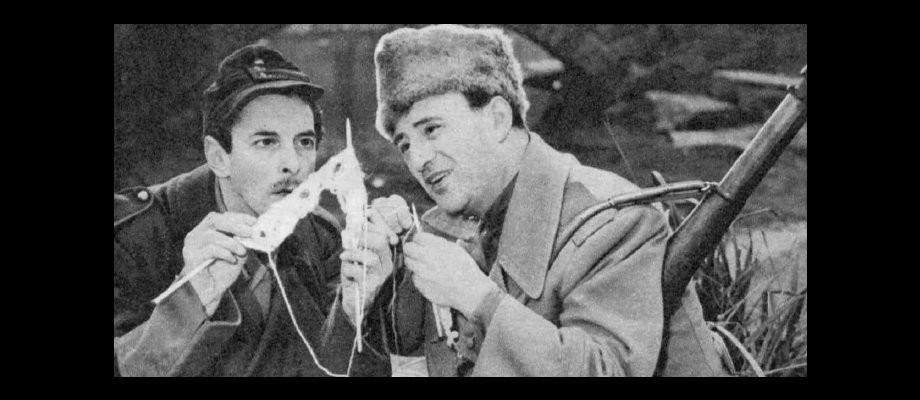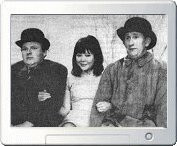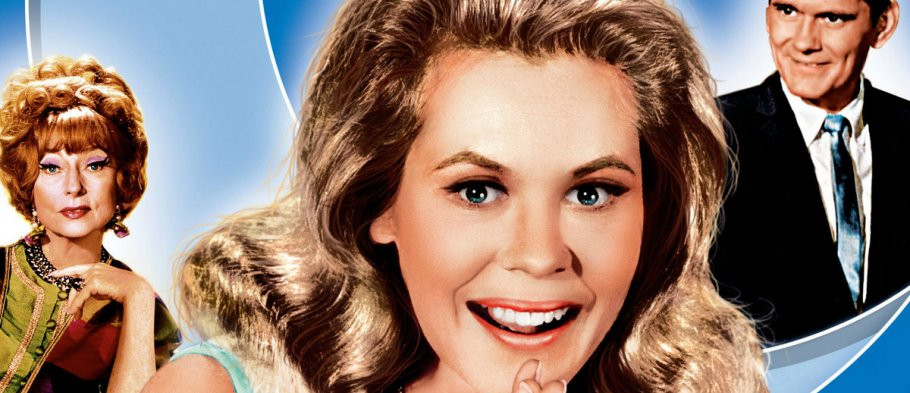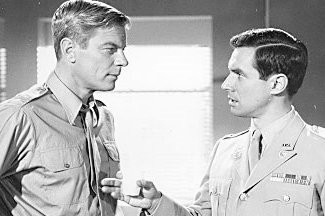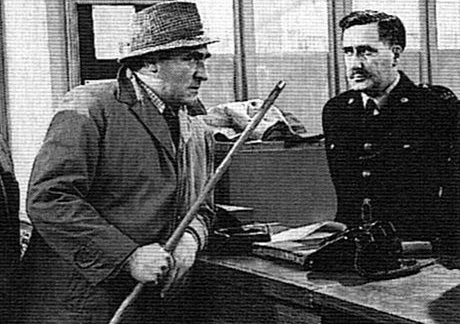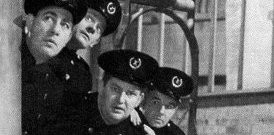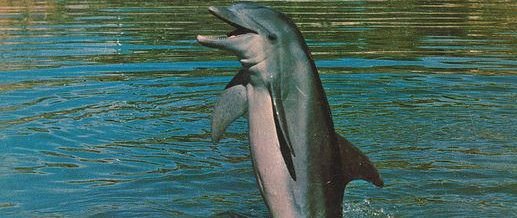
A Choice of Coward
1964 - United KingdomThese four Noel Coward plays, made by Granada and broadcast over a month in 1964 in their Play Of The Week schedule, were slotted into an abundance of one off dramas being produced by the regional ITV companies at the time. Play Of The Week in 1964 not only showcased dramas made by Anglia, Granada and Rediffusion but also mixed highly acclaimed contemporary dramatists with titles from classic literature. One week you'd get a Noel Coward, the next a John Hopkins or a James Mitchell, then followed by an adaptation of Dostoyevsky.
The Vortex, Blithe Spirit, Present Laughter and Design For Living are very much television adaptations of their time. What does impress is the scale of the production for multi-camera presentation with designer Peter Philips going to town with what would probably have been a reasonable budget. His sets are impressively designed, ornate with Art Deco and rococo loveliness and in The Vortex there's a cheeky male nude dominating one wall of the set. A stylish reference Coward would have admired, no doubt.
They are also good examples of the work of one of the first women directing drama on television, Joan Kemp-Welch. A former actor, she enjoyed a career in theatre and film before embarking on her television directing career just as ITV and Associated Rediffusion were being formed in 1955. By the time she directed the four Coward plays for Granada, she'd already been praised for her work on adaptations of Wilde, Pinter (a Prix Italia winner for The Lover in 1963) and for her large scale presentation of A Midsummer Night's Dream in 1964, featuring cast members Jill Bennett and Peter Wyngarde, for example, who she would later reuse in the Coward plays. She continued directing on series such as Upstairs Dowstairs, Crown Court, Doomwatch, Armchair Theatre and ITV Playhouse amongst others.
Her style is crisp and efficient, suggesting that much directing from the gallery was taking place rather than being 'hands on' on the studio floor. Cameras don't travel very much in these productions but she zooms in for very big closes ups on the actors for specific emotional emphasis in the drama and slickly cues in shots from each of her cameras. She blocks her actors very well, there are some particularly precise uses of physical symmetry in Present Laughter and The Vortex for instance, and she often gets the camera down quite low, in Blithe Spirit particularly, or up high above the actors as in Present Laughter. It is highly theatrical, reflecting very much how plays were presented on television in a 'stage it as in a theatre and just point the camera' manner despite major moves over the previous decade to develop work specifically for television where the visual grammar speeds up and becomes more complex in construction. It does dovetail stylistically with Coward's own work. The plays, especially The Vortex and Design For Living, are 70 minutes of gradually mounting hysteria and Kemp-Welch choreographs the interplay between characters with visual relish and then goes for huge close-ups at very tense points in scenes, often towards the climax of the plays.
One of the biggest problems the modern viewer will have, certainly if you've watched little television drama made pre-1980, is not just with the visual construction and pace but also with the language, staging and relationships between characters. You could easily dismiss these plays as old fashioned, perhaps unable to articulate anything of relevance to a modern audience. The Noel Coward style will predispose those who are unfamiliar with his theatre work, and may only recognise him by his songs or cameo in The Italian Job, to see it as rather shallow comedy. You could be forgiven for not seeing the issues underlying the plots or not finding a subtext beyond easy laughs or, as in these cases, just finding unintentional hilarity from some of the bigger performances attempting to escape off the screen.
However, get beyond this initial resistance and you begin to understand that Coward was reflecting the society in which he was operating. Actor Garry Essendine's plight in Present Laughter could quite easily be seen as similar to that which many actors suffer from in the present day: sexual immorality and the cult of celebrity. You'll find all the wit, comedy and farce inimical to Coward's work but scratch that shiny surface and you also find searing examinations of real people and their hang-ups. All human frailty and failure is here: amorality, vanity, selfishness.
Coward was also commenting on the milieu he worked in, that of the theatre and actors/writers who could not see beyond the artifice of their own creations, their own self-love. Present Laughter is all about an actor/writer who finally rejects the whirlwind of hangers-on and his own reputation in order to find his true self, the one that his ex-wife clearly empathises with. Peter Wyngarde and Ursula Howells play this to perfection in Gerald Savory's adaptation and ironically we can even look back on Wyngarde's own career as one that became overtly saddled with camp knowingness (see Department S and Jason King for the evidence) and a self-love that essentially choked his abilities as a serious actor. He's brilliant in this and it's a role entirely suited to him.
Margaret Johnston is a force of nature in The Vortex as a mature woman, Florence Lancaster, who lives vicariously through her young son and what could be described as her addiction to toyboys. Johnston’s clear awareness of her own campness and artifice in the role and the character’s brittle and selfish relationships with younger men is deposited within a country house setting. Here a party reveals raw emotions and not only a lecture from a well-intentioned friend about her love for younger men but also the troubling matter of a son, Nicky, who is a drug addict and is struggling with his own sexuality. The sexuality of Florence and Nicky drives the narrative, and quite explicitly in Florence's attraction to young men. Coward certainly encourages you to see Nicky as a gay man confused and sublimating his denial through addiction and attempting to get engaged to an impressionable girl, Bunty, to try and avoid the inevitable.
Kemp-Welch does give her actors a lot of freedom to the point where Hattie Jacques is splendidly eccentric and athletic in Blithe Spirit and Margaret Johnston and Peter Wyngarde push their theatricality forcefully out of the screen. Even a young James Bolam's turn in Present Laughter is a little overwrought. They are also terrifically physical performances, Johnston's being fabulously tormented. But there are some hugely sophisticated and subtler performances - Jill Bennett, John Wood and Daniel Massey are the glue that holds together Design For Living, Helen Cherry hilarious as Ruth Condomine in Blithe Spirit, as are both Barbara Murray, sublime as the silky femme fatale Joanna Lyppiatt, and Joan Benham, superb as Wyngarde's secretary Monica, in Present Laughter.
Design for Living, written in 1933, might be regarded as somewhat tame in this age of metrosexuality but Coward's comedy of manners is precise about how not everyone should be forced to conform to the traditional mould of 'family life' imposed by society and reflects many of the issues of the day regarding gay marriage, non-traditional relationships and alternative families. The 'la ronde' of relationships between decorator Gilda, playwright Leo and painter Otto all settles down in the end when they decide to live with and love each other much to the absolute horror of their 'straight' friends and loved ones. This tryst is set against some of Peter Philips' grandest set designs and delicious performances from Massey, Wood and Bennett. Massey and Wood are, in and of themselves, an amusing double act that more modern versions of the play stridently code as gay.
Blithe Spirit, examining as it does the themes of marriage, infidelity and loyalty, climaxes with Charles Condomine's release from the repressing presence of his two wives. As they become ineffectual spirits he has the burden of the women in his life removed. He cries, "Now I'm free, Ruth dear, not only of Mother and Elvira and Mrs. Winthrop-Lewellen, but free of you too, and I should like to take this farewell opportunity of saying I'm enjoying it immensely." Coward returns Condomine to the status of 'bachelor gay' with all the connotations that implies and he obviously sees that as the true freedom for the man about town who epitomises taste and sophistication.
Coward underwent something of a renaissance in the 1960s which may have had something to do with his and Rattigan's influence on the likes of Osbourne and Pinter finally getting due acknowledgement and with the fact that his writing about the changing sexual mores and moralities of his own set gained new significance in that progressive decade. Each play has a filmed introduction from Coward and, ironically, he does have a go at the 'angry young men' of the theatre and their depressing plays in the introduction to Blithe Spirit. These are fascinating slices of 1960s produced drama. It begs the question of why broadcasters have seemingly abandoned the practice of presenting 20th Century dramatists in prime time and suggests a partial abandonment of the Reithian idea that television would offer culture to the masses whether you wanted it or not. Modern versions of Design For Living or The Vortex would be at home on BBC4, or BBC2 for that matter, because they remain as powerful as ever and still have something to say to audiences old and new.
Published on March 26th, 2019. Written by Frank Collins for Television Heaven.


